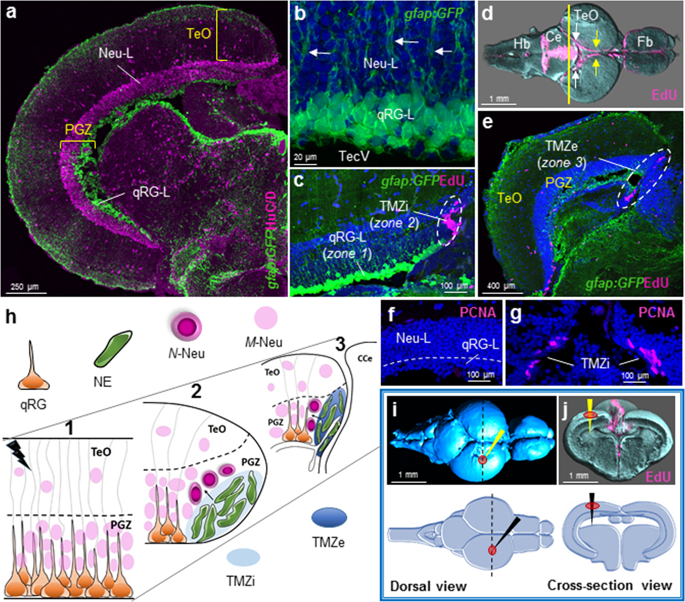Scientific Reports ( IF 3.8 ) Pub Date : 2019-03-14 , DOI: 10.1038/s41598-019-40734-z Benjamin W. Lindsey , Georgia E. Aitken , Jean K. Tang , Mitra Khabooshan , Alon M. Douek , Celia Vandestadt , Jan Kaslin

|
How diverse adult stem and progenitor populations regenerate tissue following damage to the brain is poorly understood. In highly regenerative vertebrates, such as zebrafish, radial-glia (RG) and neuro-epithelial-like (NE) stem/progenitor cells contribute to neuronal repair after injury. However, not all RG act as neural stem/progenitor cells during homeostasis in the zebrafish brain, questioning the role of quiescent RG (qRG) post-injury. To understand the function of qRG during regeneration, we performed a stab lesion in the adult midbrain tectum to target a population of homeostatic qRG, and investigated their proliferative behaviour, differentiation potential, and Wnt/β-catenin signalling. EdU-labelling showed a small number of proliferating qRG after injury (pRG) but that progeny are restricted to RG. However, injury promoted proliferation of NE progenitors in the internal tectal marginal zone (TMZi) resulting in amplified regenerative neurogenesis. Increased Wnt/β-catenin signalling was detected in TMZi after injury whereas homeostatic levels of Wnt/β-catenin signalling persisted in qRG/pRG. Attenuation of Wnt signalling suggested that the proliferative response post-injury was Wnt/β-catenin-independent. Our results demonstrate that qRG in the tectum have restricted capability in neuronal repair, highlighting that RG have diverse functions in the zebrafish brain. Furthermore, these findings suggest that endogenous stem cell compartments compensate lost tissue by amplifying homeostatic growth.
中文翻译:

中脑顶盖干细胞在斑马鱼中显示出不同的再生能力
人们对成年干细胞和祖细胞对脑部损伤后如何再生组织的了解甚少。在高度再生的脊椎动物中,例如斑马鱼,放射状神经胶质(RG)和神经上皮样(NE)干细胞/祖细胞在损伤后有助于神经元修复。然而,并不是所有的RG在斑马鱼大脑动态平衡过程中都充当神经干/祖细胞,这对受伤后静态RG(qRG)的作用提出了质疑。为了了解qRG在再生过程中的功能,我们在成年中脑盖骨中进行了刺伤,以稳态qRG人群为目标,并研究了它们的增殖行为,分化潜能和Wnt /β-catenin信号传导。EdU标记显示少量损伤后增殖的qRG(pRG),但后代仅限于RG。然而,损伤促进了内祖边缘区(TMZi)中NE祖细胞的增殖,从而导致再生神经再生的增强。损伤后在TMZi中检测到增加的Wnt /β-catenin信号传导,而在qRG / pRG中Wnt /β-catenin信号的稳态水平仍然存在。Wnt信号的衰减表明损伤后的增殖反应是Wnt /β-catenin独立的。我们的研究结果表明,qRG在大脑皮层中的神经元修复能力受到限制,这突出表明RG在斑马鱼的大脑中具有多种功能。此外,这些发现表明内源性干细胞区室通过放大稳态生长来补偿丢失的组织。损伤后在TMZi中检测到增加的Wnt /β-catenin信号传导,而在qRG / pRG中Wnt /β-catenin信号的稳态水平仍然存在。Wnt信号的衰减表明损伤后的增殖反应是Wnt /β-catenin独立的。我们的研究结果表明,qRG在大脑皮层的神经元修复能力受到限制,这突显了RG在斑马鱼的大脑中具有多种功能。此外,这些发现表明内源性干细胞区室通过放大稳态生长来补偿丢失的组织。损伤后在TMZi中检测到增加的Wnt /β-catenin信号传导,而在qRG / pRG中Wnt /β-catenin信号的稳态水平仍然存在。Wnt信号的衰减表明损伤后的增殖反应是Wnt /β-catenin独立的。我们的研究结果表明,qRG在大脑皮层的神经元修复能力受到限制,这突显了RG在斑马鱼的大脑中具有多种功能。此外,这些发现表明内源性干细胞区室通过放大稳态生长来补偿丢失的组织。强调RG在斑马鱼的大脑中具有多种功能。此外,这些发现表明内源性干细胞区室通过放大稳态生长来补偿丢失的组织。强调RG在斑马鱼的大脑中具有多种功能。此外,这些发现表明内源性干细胞区室通过放大稳态生长来补偿丢失的组织。











































 京公网安备 11010802027423号
京公网安备 11010802027423号